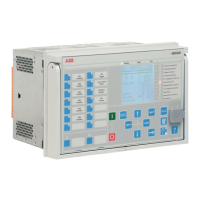Timer
The duration of the TRIP output signal from TRPPTRC can be adjusted with the
Trip pulse time
setting when the "Non-latched" operation mode is used. The pulse
length should be long enough to secure the opening of the breaker. For three-pole
tripping, TRPPTRC has a single input OPERATE, through which all trip output signals
are routed from the protection functions within the protection relay, or from
external protection functions via one or more of the protection relay's binary inputs.
The function has a single trip output TRIP for connecting the function to one or
more of the protection relay's binary outputs, and also to other functions within the
protection relay requiring this signal.
The BLOCK input blocks the TRIP output and resets the timer.
Lockout logic
TRPPTRC is provided with possibilities to activate a lockout. When activated, the
lockout can be manually reset after checking the primary fault by activating the
RST_LKOUT input or from the LHMI clear menu parameter. When using the "Latched"
mode, the resetting of the TRIP output can be done similarly as when using the
"Lockout" mode. It is also possible to reset the "Latched" mode remotely through a
separate communication parameter.
The minimum pulse trip function is not active when using the "Lockout"
or "Latched" modes but only when the "Non-latched" mode is selected.
The CL_LKOUT and TRIP outputs can be blocked with the BLOCK input.
Table 782: Operation modes for the TRPPTRC trip output
Mode Operation
Non-latched The
Trip pulse length
parameter gives the
minimum pulse length for TRIP
Latched
TRIP is latched ; both local and remote clear-
ing is possible.
Lockout
TRIP is locked and can be cleared only locally
via menu or the RST_LKOUT input.
5.3.5 Application
All trip signals from different protection functions are routed through the trip logic.
The most simplified application of the logic function is linking the trip signal and
ensuring that the signal is long enough.
The tripping logic in the protection relay is intended to be used in the three-phase
tripping for all fault types (3ph operating). To prevent the closing of a circuit
breaker after a trip, TRPPTRC can block the CBXCBR closing.
TRPPTRC is intended to be connected to one trip coil of the corresponding circuit
breaker. If tripping is needed for another trip coil or another circuit breaker which
needs, for example, different trip pulse time, another trip logic function can be
used. The two instances of the PTRC function are identical, only the names of the
functions, TRPPTRC1 and TRPPTRC2, are different. Therefore, even if all references
are made only to TRPPTRC1, they also apply to TRPPTRC2.
1MRS757644 H
Protection related functions
620 series
Technical Manual
817

